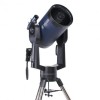Meade LX90-ACF 10 inch User Manual - Page 21
Go To Saturn, Using the Guided Tour
 |
View all Meade LX90-ACF 10 inch manuals
Add to My Manuals
Save this manual to your list of manuals |
Page 21 highlights
21 Tip: The GO TO key also allows you to perform a "spiral search". A spiral search is useful when the telescope slews to an object, but that object is not visible in the eyepiece after the telescope finishes its search. (This sometimes occurs during an alignment procedure.) Press GO TO when the telescope stops slewing. The telescope begins to move in a spiral pattern at a very slow speed around the search area.When the object does become visible, press MODE to stop the spiral search. Then use the Arrow keys to center the object. Go To Saturn After performing the Easy Alignment procedure, the motor drive begins operating and the telescope is aligned for a night of viewing. Objects in the eyepiece should maintain their position even though the Earth is rotating beneath the stars. IMPORTANT NOTE: Once aligned, only use the GO TO or Arrow keys to move the telescope. Do not loosen the telescope locks (Pg. 7, Fig. 1, 6 and 9), or move the base manually, or alignment will be lost. Once the telescope is aligned, you may choose and "Go To" any object listed in AutoStar's Object menu. This exercise demonstrates how to select one such celestial object, the planet Saturn, for viewing from the Object menu. NOTE: Saturn is not visible the entire year and you may need to choose another object from AutoStar's database; however, the procedure, as described below, remains the same. 1 After the telescope is aligned, "Select Item: Object" displays. Press ENTER. 2. "Object: Solar System" displays. Press ENTER. 3. "Solar System: Mercury" displays. Keep pressing the Scroll Down key until "Solar System: Saturn" displays. 4. Press ENTER. "Calculating" displays. Then "Saturn" and a set of coordinates displays. Note that Saturn's (and other planets') coordinates change throughout the year. 5. Press GO TO. "Saturn: Slewing..." displays and the telescope slews until it finds Saturn. You may need to use the Arrow keys to center Saturn precisely in the eyepiece. AutoStar then automatically moves the telescope so that it "tracks" Saturn (or whatever other object you may have chosen); i.e., Saturn remains centered in the eyepiece. After you Go To Saturn, practice the Go To feature with other objects in the Object menu lists. For example, during Winter, choose M42, the Orion nebula, from the Messier list. Or in the summer, choose the Dumbbell nebula from the Deep Sky, Named Objects list. Using the Guided Tour This example demonstrates using "Tonight's Best" Guided Tour. 1. After observing Saturn, press MODE twice so that "Select Item: Object" displays again. 2. Press the Scroll Down key twice. "Select Item: Guided Tour" displays. 3. Press ENTER. "Guided Tour: Tonight's Best" displays. Press ENTER. NOTE: If you wish to try out other Guided Tours, press the Scroll Down key to scroll through other tour choices. When the tour you wish to select displays, press ENTER. 4. "Tonight's Best: Searching..." displays. After calculating, "Tonight's Best: Jupiter" displays. NOTE: Different objects may be displayed on a tour list on any given night. Press ENTER to display information about the object. Press GO TO to move the telescope to the object. 5. Press MODE to return to the Tour list. Press the Scroll keys to scroll through the list. Press ENTER when you find the next object you wish to observe. 6. Press and hold down MODE for two seconds to leave the Guided Tour menu. GPS Receiver Fig. 8: The GPS Receiver. LX90 Tips The Global Positioning System The Global Positioning System (GPS) is comprised of 24 satellites orbiting the Earth that are constantly transmitting their precise position and time. The system provides highly accurate, worldwide positioning and navigation information for any number of applications. GPS receivers on the Earth acquire signals from three to twelve satellites to determine the precise latitude, longitude, and time of the receiver. (Accuracy of the receiver's position may be within 10 to 15 feet.) As AutoStar uses latitude, longitude, and time information to calculate the positions of celestial objects, GPS is an ideal tool for aligning your your telescope.















